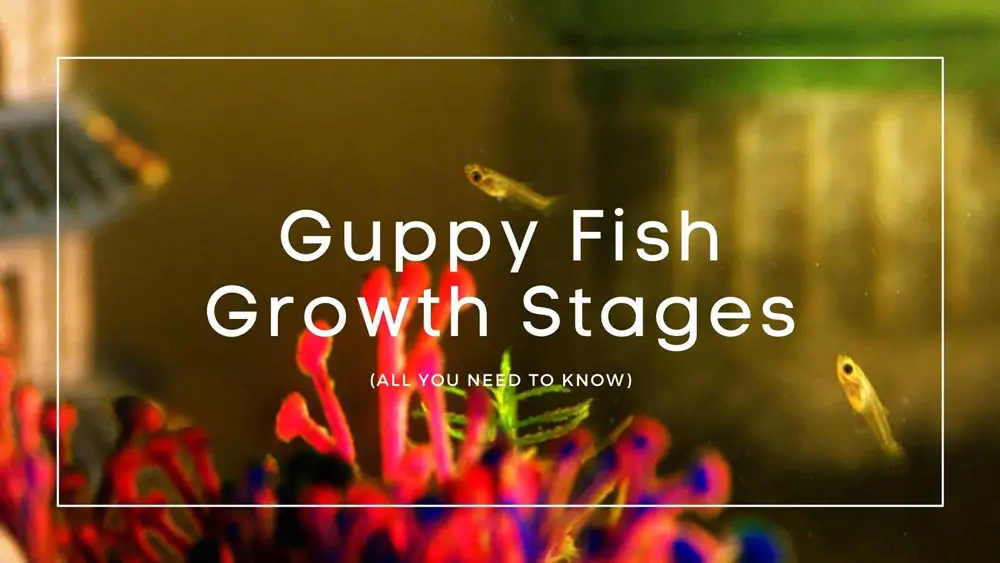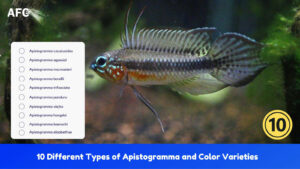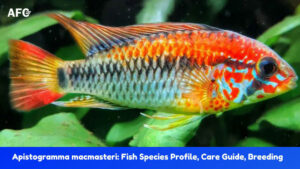If you are a guppy owner or are seeking to become one, it may be useful for you to learn the growth stages of the guppy. Knowing how to properly care for your guppy fish as they pass through each of the different stages will allow you to grow guppies which are colorful, large, long lived, and healthy.
What is the maximum size of a guppy? A male guppy can reach a length of 1.5 in or 3.8 cm, while a female guppy may attain a maximum length of 2 in or 5 cm. The following advice will enable you to grow your guppy fish to their full size in approximately five or six months.
Guppy fish are livebearers, which means they bear live young instead of laying eggs. Thus, the larva stage of the life cycle is not applicable to guppies. The female guppy is fertilized internally by the male guppy, and the guppy offspring develop within the body of the female guppy for approximately thirty days, after which the baby guppies are born.
Fry Guppies
Guppy fry are free swimming from the very beginning. As soon as the fry are born, they will immediately begin to look for a place in which they can hide. Right after birth, the shape of their bodies are deformed, but a few hours later, their bodies straighten out. They then become strong enough to begin feeding.
The fry are tiny: they have a length of approximately ¼ of an inch or 0.6 mm. It is common for larger fish or adult guppies to eat them or to attempt to do so. In order to save the fry from such a fate, try separating a pregnant guppy from other fish. You can also try to give the fry ample hiding spots, like live plants.
Baby guppies share the same diet as their parents. But note that when feeding guppy fry with flake foods, you should crush the flakes into a fine powder to make it easier for the fry to eat. Live food is also excellent for guppy fry, especially baby brine shrimp which is the best food available for them. You can also help them grow significantly by feeding them with the yolk of an egg that has been hard boiled.
Furthermore, another way to contribute to the growth of guppy fry is to leave the light on for twelve to sixteen hours per day.
The water in your tank must be changed frequently, particularly if your baby guppies are fed several times a day. Guppy breeders sometimes change the water completely every day or once every two days.
Guppy fry become juvenile guppies at approximately the one month mark.

Juvenile Guppies
Juvenile guppies begin gaining color, and the sex becomes distinguishable. Males have a smaller tail and begin coloring up, while females are significantly larger and have a visible gravid spot. This is the beginning of the formation of male guppies’ gonopodium.
This is a very important stage in the guppy life cycle in which the best water and food must be supplied to them. Feed the juvenile guppies with brine shrimp, high quality fish flakes, blood worms, spirulina, beef hart, and plankton pellets.
The length of juvenile guppies is from ¼ in to ¾ in, or 1.2 cm to 2 cm. When they are approximately two months old, their sexual maturation begins and they are considered young guppies.

Young Guppies
Young guppies begin to be sexually active when they are about two months old. Guppy breeders will often separate females from males when they are juveniles. The separation promotes the growth of the guppies, because they will be focused exclusively on feeding, not on reproduction.
Young guppies require a slightly different diet; their fat intake should be lowered, and they should receive more greens and more protein. Brine shrimp is still the best food for them. Plankton pellets and spirulina will enable them to develop more intense, richer color.
Young guppies turn into adults at approximately six months of age.

Adult Guppies
The growth of an adult guppy will slow significantly or stop. Male guppies’ tail and fins may continue to grow over time (it depends on their genes).
Keeping guppies colorful and healthy requires supplying them with a varied diet. The main food for adult guppies ought to be flake food which is protein-rich. Try not to feed them fat, which can negatively impact their health.
Guppies can survive for two to five years. Once an adult guppy is 1 ½ or two years old, it is usually infertile and can no longer reproduce.
Conclusion
Breeding guppies, determining the stage they are in, and caring for them accordingly will now be easy for you, since you now know the life cycle of a guppy. Just follow the instructions to get guppies that are as healthy, colorful, and long-lived as possible.






2 thoughts on “Guppy Fish Growth Stages”
I have a fry that is active and feeds well but it is not growing. The body is still as small as a two week old guppy and still bent in shape but he is almost 2 months old. The other fry are at least double his size.
Hey Cynthia
Generally, if guppies are born with a bent spine, it is an indication of inbreeding. But, these fish rarely live long and healthy.
In your case, I think that due to genetic problems. Have you noticed scoliosis in females?